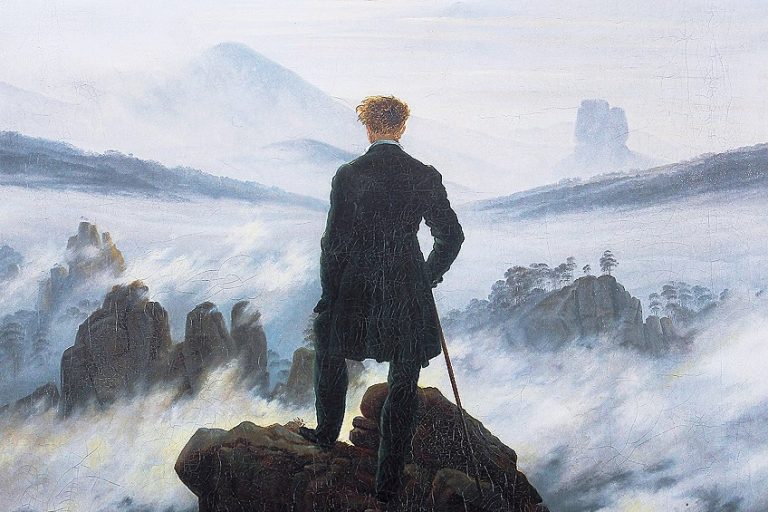John Singer Sargent Watercolor Paintings – The Best of This Artist
A master of manipulating light and special effects in painting, John Singer Sargent was one of the best portraitists of the 20th century, celebrated widely for his contributions to Edwardian-era luxury aesthetics and the post-Impressionist style. In addition to capturing the movement, light, complex colors, and subjects of a scene, Sargent was also an expert watercolorist, who created more than 2,000 watercolor works in his lifetime. In this article, we will browse through 14 John Singer Sargent watercolor paintings that showcase the artist’s brilliance in the medium.
The Allure of John Singer Sargent’s Watercolor Paintings
John Singer Sargent had a beautiful way of viewing the world around him and this was best seen in his many watercolor studies and sketches of people, places, and scenes that were painted into life. Born in 1856 in Italy to American parents, Sargent moved through academic spaces in Italy, Germany, and Paris to discover and hone his talents in painting. In his lifetime, he created more than 2,000 watercolor paintings and some 900 oil works, not counting the countless sketches and charcoal drawings in his portfolio.

The American artist never married and maintained a tight-knit circle of friends. One of his mentors was Emile Auguste Carolus-Duran, who was better known as Carolus-Duran, and perhaps inspired Sargent to explore high society and portraiture. One of Sargent’s main methods of working in his signature post-Impressionist style was his use of the alla prima method, where he worked with paint directly from a brush onto his canvas. This approach required him to have a thorough understanding of color and its application to the right parts of the composition, such that the work did not appear unfinished, but rather, skillfully approached in terms of color placement.
So, what made his watercolor works so appealing? Sargent’s examples of work in pen and ink are only snippets of his talents in watercolor. If one examines Sargent’s works, one will notice that he was confident in his color placement, which has also been compared to similar effects in high-dynamic range photography (HDR).
His most notable qualities in painting also include his rendering of light and knowledge of spaces, movement, and the effects that light casts on objects, the atmosphere, and shifts in perspective and depth. Sargent’s knowledge of surfaces is also evident in his watercolor paintings, which reflect his philosophy in painting to create freely, using large brush strokes, washes, with good paper, and even wax resist effects. Most importantly, the aspect that made Sargent’s painting style stand out was his unapologetic coverage of surfaces that showcased his knowledge of texture and wisdom in knowing when to apply varying amounts of pigment to render an object or surface in a way that brings it to life.
14 Masterful John Singer Sargent Watercolor Paintings
Capturing the nuances of light and its effects on different surfaces seemed to come to Sargent as second nature. It was a language only a few post-Impressionists could truly speak with clarity and yet, Sargent managed to achieve such a variety of textures in his watercolor paintings. For a more comprehensive overview of Sargent’s watercolor paintings, one can refer to the publication John Singer Sargent: Watercolors, which features over 100 watercolor artworks from the Museum of Fine Arts, Boston, and the Brooklyn Museum of Art. Below, we will introduce you to a selection of John Singer Sargent’s paintings that were rendered so masterfully that one might even mistake them for oil paintings!

Splendid Mountain Watercolours (1870)
| Date | 1870 |
| Medium | Watercolor, graphite, and gouache on pale blue wove paper |
| Dimensions (cm) | 27.6 x 40.6 |
| Where It Is Housed | Metropolitan Museum of Art, New York City, United States |
Splendid Mountain Watercolours is one of the most intimate and amazing collections of John Singer Sargent that was created in a sketchbook during the artist’s travels to Switzerland’s Bernese Alps in 1870. Sargent’s notebook reveals around 14 watercolor paintings of the surrounding landscape and his keen eye for observing all the beautiful details of his journey. A visual diary and preservation of the places he found visually unforgettable, Sargent immortalized these landscapes during a three-week-long hike with his father in June 1870, as well as on his family vacation in Mürren. The collection of paintings reflects his study of John Ruskin’s painting techniques that were popular at the time.
Sargent, who had no formal training at the time, innovated his own methods to depict the delicate surfaces of the mist, snow, and icy terrain.
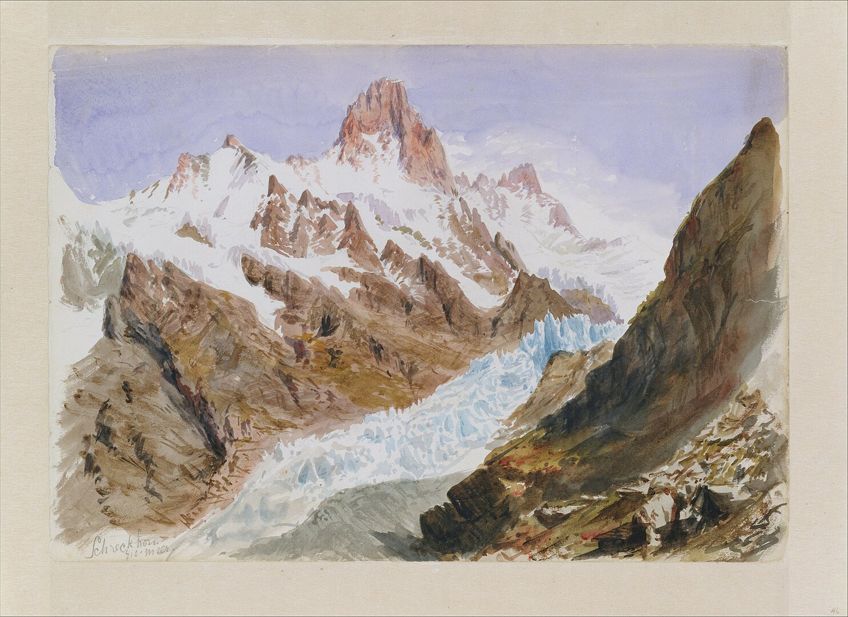
Young Man in Reverie (1876)
| Date | 1876 |
| Medium | Watercolor on paper |
| Dimensions (cm) | 76.2 x 61 |
| Where It Is Housed | The Brooklyn Museum, New York City, United States |
In a brilliant rendering of contrast and emotion, Sargent expertly painted Young Man in Reverie against a porcelain white background while the young man poses with his chest exposed and his hand on his hip. The many fine details of this work make it compositionally masterful and can be noted in Sargent’s treatment of the man’s hair, which was rendered in a rougher unblended quality than the rest of the elements.
The decoration on the porcelain in the background also leaves the impression of a painterly effect that Sargent used to portray the objects as “decorative” while the rest of the background is filled with grays and whites, as well as a fuzzy shadow against the man’s back to illustrate his shadow.
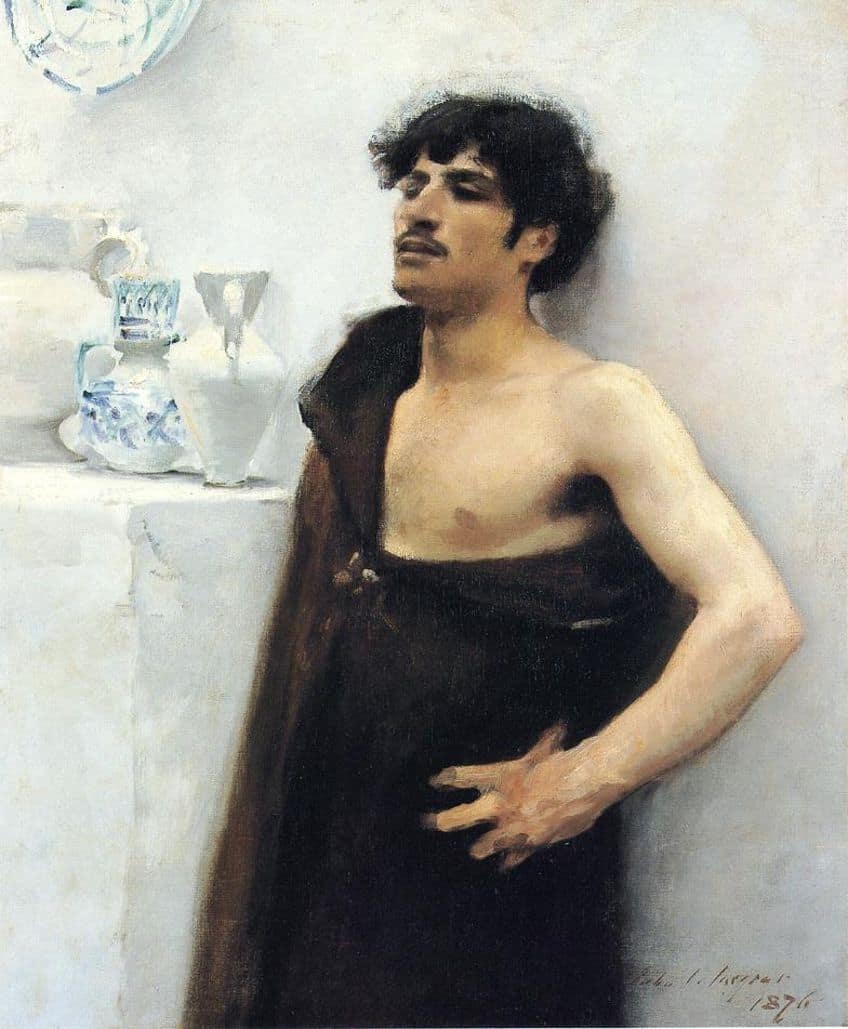
Venetian Canal, Palazzo Corner (c. 1880)
| Date | c. 1880 |
| Medium | Watercolor on paper |
| Dimensions (cm) | 31.75 x 22.86 |
| Where It Is Housed | Art Renewal Center Museum, New Jersey, United States |
Most of Sargent’s paintings of Venice portray the city in a romantic palette that was usually inspired or studied directly from the way that natural light shone on the architecture and water of the canal. Sargent’s portrayal of the city in Venetian Canal, Palazzo Corner showcases his knowledge of color placement in an Impressionistic painting style that can be seen in his use of negative and positive space. Sargent left select portions of the paper empty or “negative” to represent the parts of the water that reflected the atmosphere.
It was as though Sargent observed through the lens of color first and then added in the smaller details such as boats and darker elements to the scene.
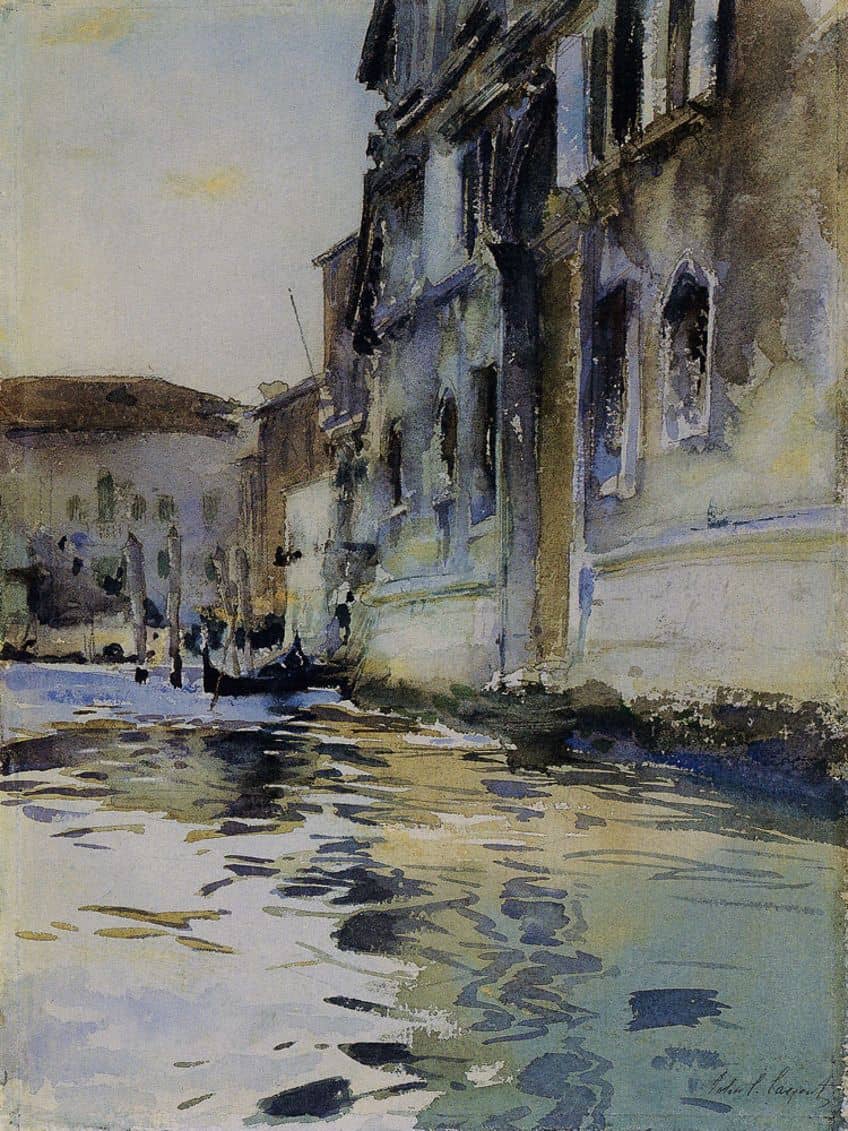
The Bridge of Sighs (1903 – 1904)
| Date | 1903 – 1904 |
| Medium | Translucent and opaque watercolor, graphite, and red-pigmented underdrawing on paper |
| Dimensions (cm) | 25.4 x 35.6 |
| Where It Is Housed | The Brooklyn Museum, New York City, United States |
The Bridge of Sighs is one of the best examples of Sargent’s use of impasto to create texture and depth in a watercolor artwork. Here, Sargent used white impasto on the figures of the boat and the gondoliers, which provides a balance of light to the composition. He also reserved an area of paper as negative space to represent the top of the arch and applied a hard wash of blue around it to outline the atmosphere. Sargent’s ability to craft a composition from space and color in creative ways was evident in this painting and many others.
One can also observe the area around the gondola’s prow, where Sargent removed wet paint and soft highlights created by dry scraping seen in the distant building beyond the arch.

Saddle Horse, Palestine (1905)
| Date | 1905 |
| Medium | Watercolor on paper |
| Dimensions (cm) | 35.6 x 25.4 |
| Where It Is Housed | Private collection |
Saddle Horse, Palestine is a lesser-known watercolor painting by John Singer Sargent that was created in 1905 and depicts the hind of a saddle horse standing next to a stone wall with a visible arch. The blue-gray tone of the horse brings the horse to life and adds a wonderful cool tone to the otherwise warm mood of the scene. One can almost envision the heat of Palestine, which Sargent may have visited. The subtle streaks of blue outline the structure of the horse’s body and grow more translucent toward the horse’s head to illustrate distance. The stones in the painting are also reminiscent of Jerusalem stone, which has been viewed as a symbol of colonial erasure and the primary construction material of the city for centuries. These stones are quarried from the central highlands of Palestine, as well as areas surrounding the city, and are known to give the cityscape its signature golden tint. This painting was created only years before the British colonial forces entered Palestine under Sir Ronald Storrs, who declared that all new buildings should be built with Jerusalem stone.
Sargent’s Saddle Horse, Palestine is therefore not only a delicate animal painting but also perhaps unintentionally symbolic.

In a Levantine Port (1905 – 1906)
| Date | 1905 – 1906 |
| Medium | Translucent watercolor and opaque watercolor with a graphite underdrawing |
| Dimensions (cm) | 30.6 x 46 |
| Where It Is Housed | The Brooklyn Museum, New York City, United States |
In a Levantine Port is one of many port paintings by Sargent that focuses on the vibrancy of the scene such that it offers more of an experience than a detailed study of the site. One of Sargent’s best painting qualities was his ability to add transparency of color and light on various surfaces. The textures of the boats and their metallic and wooden elements are all highlighted in the painting through the rust-kissed hulls. Compositionally, one is also guided by the boat’s anchor rode to observe the streaks of light and shadow that the sun illuminates.
The painting possesses a graphite underdrawing and contains many linear elements that make it visually interesting.
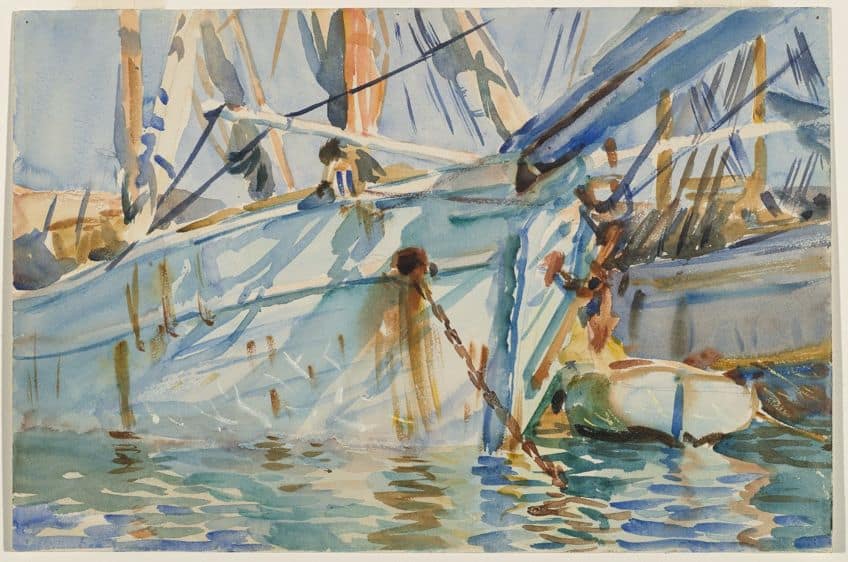
In a Medici Villa (1906)
| Date | 1906 |
| Medium | Watercolor and graphite on paper |
| Dimensions (cm) | 53.8 x 36.5 |
| Where It Is Housed | The Brooklyn Museum, New York City, United States |
In a Medici Villa is a vivid watercolor painting by John Singer Sargent that gives one a window into the Renaissance garden of the Medici family at the Villa Medici di Castello. The residence’s garden was designed by Niccolò Tribolo and built on an incline. Among the geometric forms and shapes of the garden’s hedges were also a series of grand fountains created by Benedetto Varchi.
In this study of a fountain from the Medici garden, Sargent cropped the Hercules and Antaeus fountain to focus on the decorative carvings and tinted shadows of the wide basins that convey the warmth of the light while touching on the classical “antiquity” of the stone.

Gourds (1908)
| Date | 1908 |
| Medium | Watercolor and graphite on paper |
| Dimensions (cm) | 35.1 x 50 |
| Where It Is Housed | The Brooklyn Museum, New York City, United States |
Sargent’s masterful rendition of natural light and leafy textures was executed incredibly well in Gourds, which was created in 1908. The artwork was created during Sargent’s stay in Majorca during the summer and depicts the sculptural forms of the fruits rendered in a fresh and brilliant ray of light that was speckled through the leaves. Sargent emphasized the luminosity of the scene by using thin opaque washes to cover the exposed parts of the paper. Painted in such immaculate detail, the leafy textures of the work reveal the meticulous observation skills of Sargent as he presents a scene that immerses the viewer into a snapshot of a summer scene.
One might even be tempted to imagine the glimmers of sunlight hitting one’s own skin.

Villa di Marlia, Lucca: A Fountain (1910)
| Date | 1910 |
| Medium | Translucent and opaque watercolor with wax resist and graphite on paper |
| Dimensions (cm) | 40.4 x 53.1 |
| Where It Is Housed | Museum of Fine Arts, Boston, Massachusetts, United States |
As part of the Hayden Collection at the Museum of Fine Arts Boston, Villa di Marlia, Lucca: A Fountain is a well-known watercolor painting by Sargent that was created in 1910. What makes this painting immediately catch your eye is the almost photographic nature of the background that Sargent rendered in splotchy patches of color. Sargent was known to employ wax resist methods in his works to ensure he created an opaque effect that muted down select colors to push forward other elements into the foreground. He also used wax-resist effects to produce a mottled light effect.
One can spot a variety of uses that Sargent might have had for the wax resist method, from depicting rocks and plaster walls to foliage and light that appeared caught between trees or vegetation.
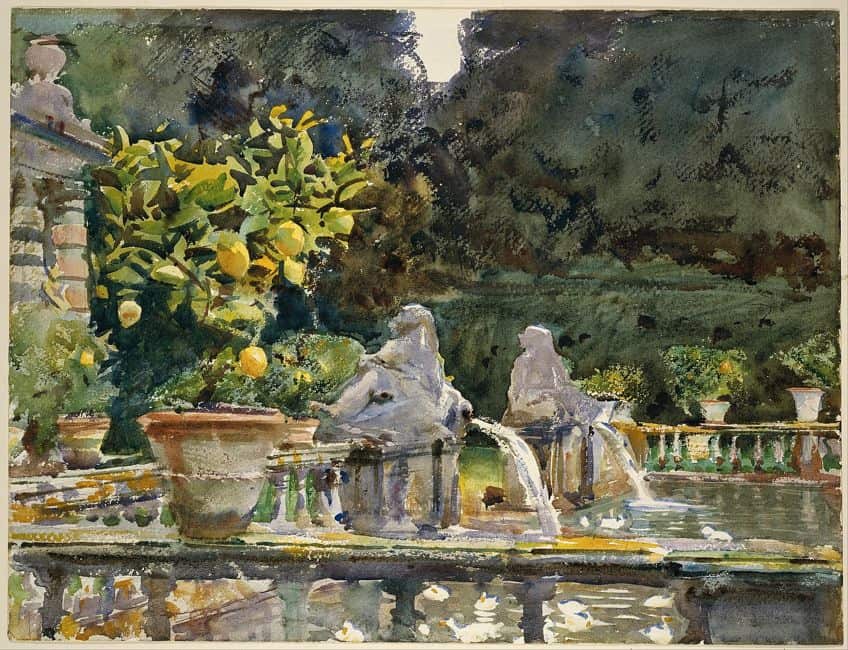
Venetian Canal (1913)
| Date | 1913 |
| Medium | Watercolor and graphite on off-white wove paper |
| Dimensions (cm) | 40 x 53.3 |
| Where It Is Housed | Metropolitan Museum of Art, New York City, United States |
This stunning watercolor and graphite painting captured a still of Venice and the Rio de San Barnaba, in the direction of the Grand Canal. Here, Sargent used flat and lengthy brush strokes to render the water and its color to reflect the sky and colors of the buildings around it. Sargent traveled frequently to Venice between 1898 and 1913 and was perhaps most captivated by the rippling effects of the water in this scene. Sargent had a keen eye for observing architecture, texture, and how different surfaces interact with each other in a space.
One is also given the impression that the scene occurs in the bright morning sunshine, as though one is traveling with Sargent in a gondola.
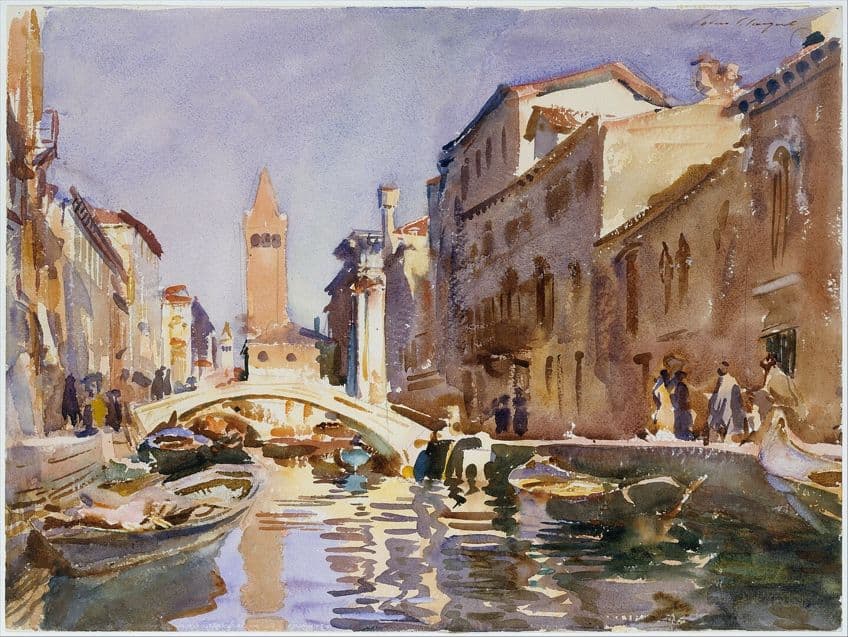
Muddy Alligators (1917)
| Date | 1917 |
| Medium | Watercolor over graphite on paper |
| Dimensions (cm) | 34.4 x 53 |
| Where It Is Housed | Worcester Art Museum, Massachusetts, United States |
Muddy Alligators is among the most famous John Singer Sargent watercolor paintings that evokes the textures and nature of the subject; alligators. The painting was created during a period when Sargent took a hiatus from portraiture and used watercolor painting to explore textures and techniques such as wax resist and bravura. For Sargent, watercolor painting was an opportunity to express himself and through Muddy Alligators, one can also identify the frustration of the artist as he worked on the painting via scratches, broad brush marks, and rough textures.
There were also several sketches that Sargent created in preparation for the painting, all of which remain with the Worcester Art Museum.
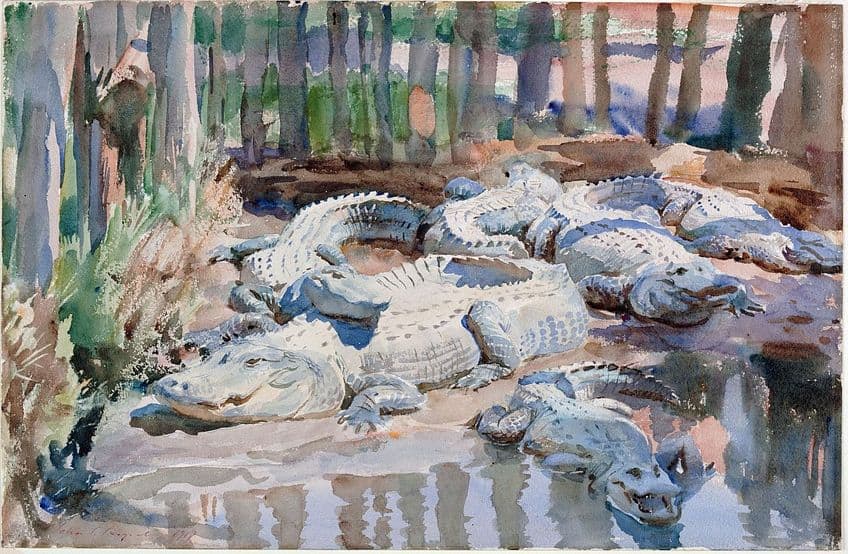
Figure in Hammock, Florida (1917)
| Date | 1917 |
| Medium | Watercolor, gouache, and graphite on white wove paper |
| Dimensions (cm) | 34.6 x 53.3 |
| Where It Is Housed | Metropolitan Museum of Art, New York City, United States |
Figure in Hammock, Florida is a famous watercolor painting by Sargent that represents a moment in February 1917, when the artist took a period of leave from the Boston Public Library mural project to destress in Florida at Ormond Beach. The painting shows a man relaxing in a hammock while reading a book and appears undisturbed. Sargent created the work while visiting his friend Charles Deering, who was also Sargent’s patron and colleague from Paris. It is believed that Deering is the man in the painting, who was captured at his home in Brickell Point with a view of the Miami River. The best painterly quality of the work is Sargent’s rendering of the flat architectural surfaces, which contrasts with the free-flowing, rough, and natural textures of the landscape.
Deering’s face is also rendered without much detail, yet the fine shadows on his face and his position in the landscape bring some character to his image.
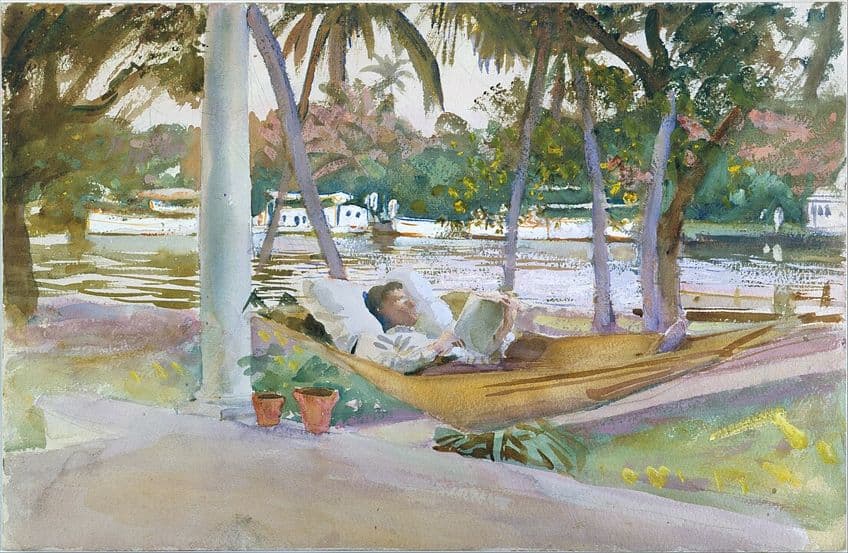
Tommies Bathing (1918)
| Date | 1918 |
| Medium | Watercolor, gouache, and graphite on white wove paper |
| Dimensions (cm) | 34.6 x 53.2 |
| Where It Is Housed | Metropolitan Museum of Art, New York City, United States |
This Impressionist yet detailed watercolor painting by Sargent is among the most visually interesting artworks. Created in 1918, Sargent produced this study of three nude men in an informal and casual bathing scene. The men are believed to be soldiers, as indicated by the color palette of the scene and the Sargent’s other watercolor works of British soldiers at the time. The title Tommies Bathing draws reference to the term “Tommy”, which was derived from a fictitious name “Thomas Atkins” usually employed by the British army on the official documents of private soldiers. This was the equivalent of the Americans’ John Doe. The striking details of the composition include the linear elements used to render the vegetation by the river bank in contrast to the softer textures and figures of the soldiers and their pale white skin.
Although the palette appears consistent in value, the directional lines of Sargent’s brushwork on the river differ from the vegetation to ensure that one identifies it as a river.
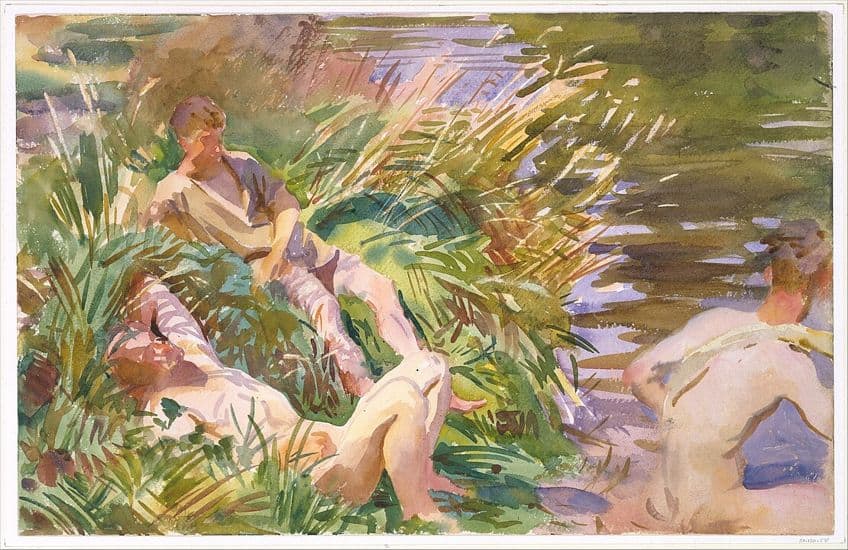
Alice Runnells James (Mrs. William James) (1921)
| Date | 1921 |
| Medium | Translucent watercolor, opaque watercolor, wax resist, and graphite on paper |
| Dimensions (cm) | 53.5 x 34.2 |
| Where It Is Housed | Museum of Fine Arts, Boston, Massachusetts, United States |
This famous Sargent watercolor artwork is a softly rendered portrait of Alice Runnells James that was created in 1921. Sargent painted Mrs. William James in a restful manner, propped up against a set of large pillows and cushioning that allow her to meet Sargent’s eyes while her head is tilted back. Her gaze is also one that appears comforted by the presence of Sargent as her hand rests by her side. The delicate pastels of her clothing and pale skin add character to Sargent’s model and are complemented by the fabric textures of the textiles around her. From the creases of the pillow folds to the cross-hatch markings on the bed frame at the bottom, there are many admirable qualities about the work. His model, Mrs. William James, was also known to suffer from neurasthenia, which also reflects aspects of Sargent’s “intenser” self, described by his friend Vernon Lee. A key component of the work is recognizing that the lower half of James’ body appears more dematerialized as compared to the “vitality” and volume of the pillows.

John Singer Sargent was truly a master of watercolor who knew how to manipulate his medium and experiment with different techniques to provide snippets of his life and early 20th-century high society. We hope that you have enjoyed browsing through our selection of the 14 best Sargent watercolor artworks, which may motivate you to try out some of the artist’s most used techniques mentioned in the article.
Frequently Asked Questions
How Many Watercolor Paintings Did John Singer Sargent Create?
Throughout his lifetime, John Singer Sargent created over 2,000 watercolor paintings, alongside 900 oil artworks and numerous other charcoal drawings and graphite sketches.
What Was John Singer Sargent’s Watercolor Palette?
A few hues and shades found in most watercolor artworks by John Singer Sargent include burnt sienna, alizarin carmine, chrome yellow, viridian, brown-pink, gamboge, cadmium yellow pale, lamp black, cobalt blue, vandyke brown, rose madder, deep vermillion, ultramarine blue, opaque white, and scarlet vermillion, among other variations.
What Is the Value of John Singer Sargent’s Paintings?
John Singer Sargent’s paintings have been known to sell for up to $23.5 million on auction since 1998.
Who Owns the Largest Collection of John Singer Sargent Paintings?
The Museum of Fine Arts in Boston, Massachusetts, the United States holds the largest collection of John Singer Sargent paintings that also include his watercolor artworks, drawings, murals, and other creations.
Jordan Anthony is a film photographer, curator, and arts writer based in Cape Town, South Africa. Anthony schooled in Durban and graduated from the University of the Witwatersrand, Johannesburg, with a Bachelor of Art in Fine Arts. During her studies, she explored additional electives in archaeology and psychology, while focusing on themes such as healing, identity, dreams, and intuitive creation in her Contemporary art practice. She has since worked and collaborated with various professionals in the local art industry, including the KZNSA Gallery in Durban (with Strauss & Co.), Turbine Art Fair (via overheard in the gallery), and the Wits Art Museum.
Anthony’s interests include subjects and themes related to philosophy, memory, and esotericism. Her personal photography archive traces her exploration of film through abstract manipulations of color, portraiture, candid photography, and urban landscapes. Her favorite art movements include Surrealism and Fluxus, as well as art produced by ancient civilizations. Anthony’s earliest encounters with art began in childhood with a book on Salvador Dalí and imagery from old recipe books, medical books, and religious literature. She also enjoys the allure of found objects, brown noise, and constellations.
Learn more about Jordan Anthony and the Art in Context Team.
Cite this Article
Jordan, Anthony, “John Singer Sargent Watercolor Paintings – The Best of This Artist.” Art in Context. February 5, 2024. URL: https://artincontext.org/john-singer-sargent-watercolor-paintings/
Anthony, J. (2024, 5 February). John Singer Sargent Watercolor Paintings – The Best of This Artist. Art in Context. https://artincontext.org/john-singer-sargent-watercolor-paintings/
Anthony, Jordan. “John Singer Sargent Watercolor Paintings – The Best of This Artist.” Art in Context, February 5, 2024. https://artincontext.org/john-singer-sargent-watercolor-paintings/.




